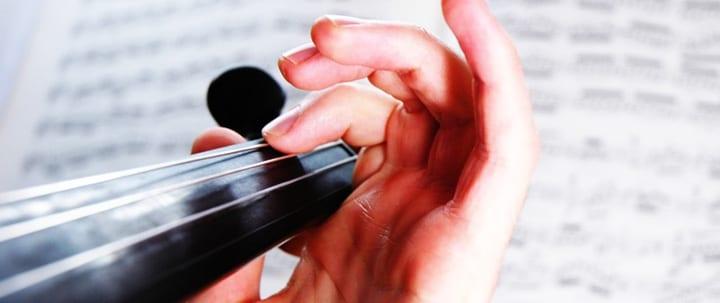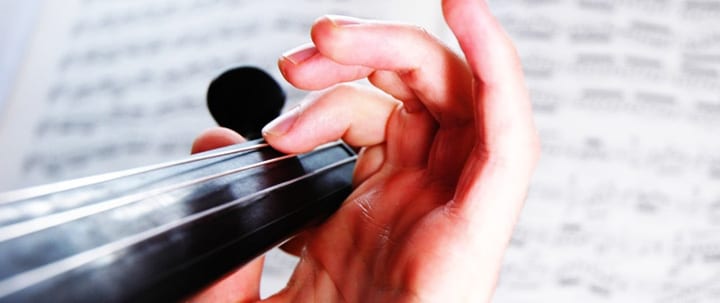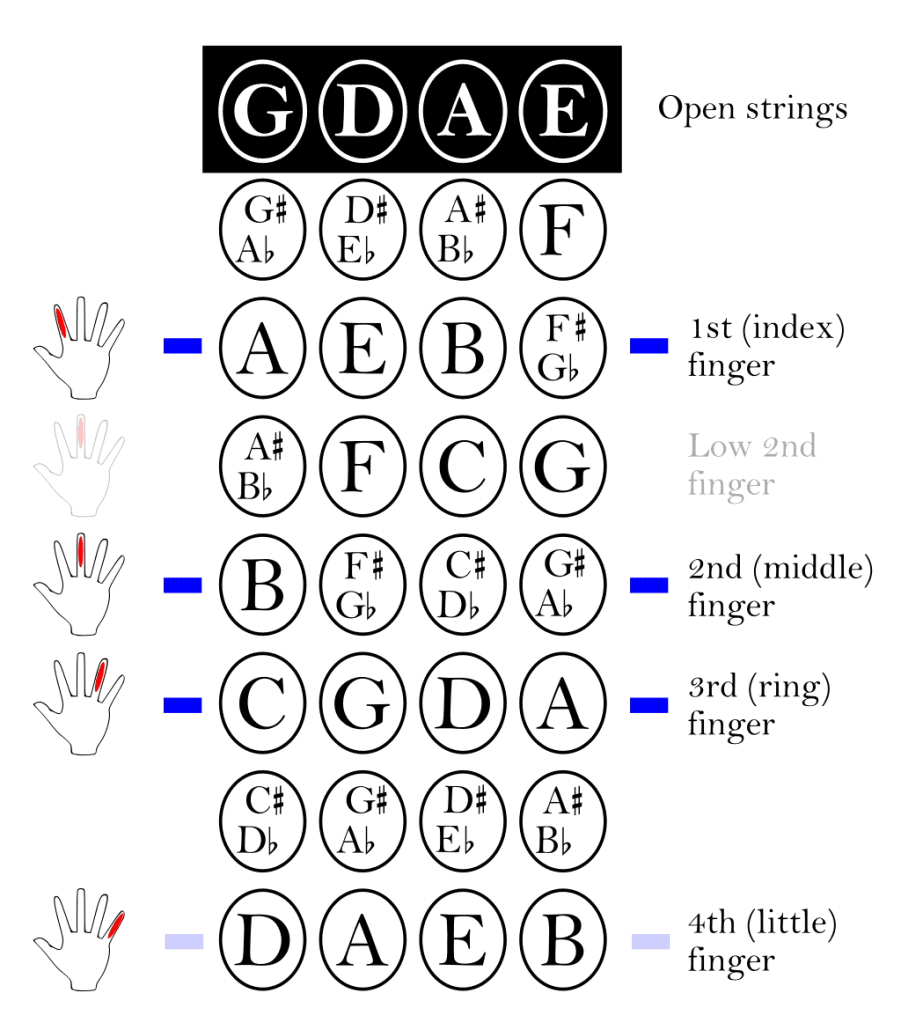When you’re learning how to play the violin, a violin fingering chart is one of your most useful resources. Before you can start wowing crowds like famous violin players Lindsay Stirling and Joshua Bell, it’s important that you first learn the basics. Starting with proper violin fingering is ideal.
In this guide, we’ll share a violin fingering chart, teach you how to use it, give you information about violin notes for beginners, and more. Let’s get started!
Can Violin Be Self Taught?
The violin is considered one of the hardest instruments to learn. With that said, you can certainly teach yourself how to play with a lot of dedication and time. Working with a violin teacher is the best way to master the skill like a pro!
If you follow these steps, you’ll be on your way to being the next great violinist:
- Use the violin fingering chart for 1st position.
- Put finger tapes on your violin.
- Label notes on the violin.
- Memorize string notes in the 1st position.
- Understand sharp and flat notes.
Keep reading to learn how you can do each of these!
To see these steps on video, check this out!
Use the Violin Fingering Chart for 1st Position
The chart below shows the first position on the violin. Having this fingering chart will help you tremendously!
There are several violin finger positions one must learn. However, as a beginner, the first one you’ll need to learn is called the first position.
The first position includes the first (or lowest) five notes that you can play on each violin string.
One of the most challenging aspects of learning the instrument is knowing where to place your fingers. This is because violins don’t have frets or marks that show you where to put your fingers the way guitars do,
If you don’t have your finger in the right spot the note can come out sounding out of tune. It shouldn’t even be a hair off!
The most common way to get around this issue is to place finger tapes on the fingerboard. This will show you the proper violin finger placement.
Over time, your fingers will develop something we call muscle memory. Eventually, you’ll be able to remove the tapes and play in tune without them. Most beginners keep their tapes on anywhere from six months to a couple of years depending on personal preference.
What You’ll Need
- Finger tape: You can find a roll of violin finger tape online or at your local violin shop. You can also purchase pinstripe tape from an automotive shop.
- Chromatic tuner or smartphone tuning app: See our list of the top 10 violin tuner apps.
- Your violin
- Pencil
Finger Tapes on Your Violin
You will first want to make sure your violin is in tune. You can tune it using a chromatic tuner or smartphone violin tuner app, as explained in this instructional video. It’s imperative to get each string exactly in tune before applying your tapes. So, check your tuning a couple of times just to be sure.
Once you’ve tuned your violin, place your first finger about two inches down from the top of the fingerboard on the G string and pluck the string. Look at your tuner and move your finger around until the tuner reads A. It should also light up green with the tuner needle in the middle of the dial signifying that your A is in tune.
You can use a pencil to mark the spot. Then, slide a three-inch-long strip of tape under the strings and press down firmly to go across the entire fingerboard and around the neck of the violin. This will be your first finger tape.
Step One: Index Finger
Place your first finger (index finger) on the tape and pluck one string at a time, looking at the tuner to make sure it reads A on the G string, E on the D string, B on the A string, and F # on the E string.
If the tuner reads each note as in tune, the tape has been placed correctly. You may need to adjust it a few times and double-check with the tuner before it is perfectly placed. The same process will follow for the placement of each tape.
Step Two: Middle Finger
The second finger tape will be placed roughly one inch away from the first tape. Adjust your second finger (middle finger) on the G string until the tuner reads B and then place your tape down.
When the second finger is placed on the second finger tape on each string, the tuner should read B on the G string, F # on the D string, C # on the A string, and G # on the E string.
Step Three: Ring Finger
The third finger tape will be placed about a half-inch or less away from the second finger tape. Adjust your third finger (ring finger) on the G string until the tuner reads C and then place your tape down.
When the third finger is placed on the third finger tape on each string, the tuner should read C on the G string, G on the D string, D on the A string, and A on the E string.
Step Four: Pinky Finger
The fourth finger tape will go down about an inch away from the third finger tape. Adjust your fourth finger (pinky finger) on the G string until the tuner reads D and then place your tape down.
When the fourth finger is placed on the fourth finger tape each string, the tuner should read D on the G string, A on the D string, E on the A string, and B on the E string.
Note: The rough one-inch etc. measurements I’m using for spacing are based on a full size or 4/4 violin. If you’re putting tape on a smaller violin, everything will be the same except that the tape will be placed closer together.
The main thing to pay attention to is getting the correct readings for the notes on the tuner.
And that’s it! Now that you have all four tapes down, you’ll know the proper violin finger placement while playing in the first position.
You might also be interested in: 25+ Violin Practice Tips to Help You Improve Fast
Label Notes on the Violin
Once you’ve put your tapes on, the next step will be to learn and memorize where each note in the first position is and how it corresponds to the tapes.
In music, we use the first seven letters of the alphabet: A, B, C, D, E, F, and G to describe each note.
Once you’ve gotten to the end of the cycle and played G, you’ll start back over with A again and the sequence will repeat.
Memorize String Notes in the First Position
As you’re learning how to play violin for beginners, you’ll definitely want to memorize the string notes. And, as long as you continue to practice, you will! Here’s how you can do that.
Looking at your violin, start with your G string and place your first finger on the first finger tape. This note would be A.
Then place your second finger on the second finger tape. This note would be B. Your third finger would be C and so forth and so on.
You can look at the violin fingering chart below to see where all of the notes fall on your tapes.
Over time, you’ll memorize all of these notes and become so familiar with them that you’ll be able to identify them without having to stop to think.
Pro tip: Making flashcards is a really great way to help you memorize the notes. Draw the note on one side and a label of the note on the other side.
Check out the violin fingering chart again if you need a visual:
There are a lot of other notes that fall in between the notes on the tapes. You’ll notice this in the chart.
However, the reason why we start with the 4 notes in the above chart is that these are the most commonly used notes and therefore the easiest to learn, especially for beginners.
Once you’ve memorized all of the notes on the tapes and where they fall on the violin, you can start to learn the notes that fall in between the tapes as illustrated in the chart.
You won’t need to put down tapes for all of these other notes. This is because after you get familiarized with the first set of notes on the tapes, you’ll be able to rely on the tapes, your fingers, and muscle memory as a guide.
Understanding Sharp and Flat Notes
Chances are you’ve noticed that there are the standard notes labeled as A, B, C, etc. Then, there are other notes such as C#, B♭, G#, and A♭.
So, what exactly do those funny symbols mean? Below are some basic guidelines to understanding these other notes:
When you see a # symbol, it means “sharp.” A sharp note, for instance a C # (C sharp), is a half-step higher than just a regular C.
When you see a ♭ symbol, it means “flat.” A flat note, for instance B♭ (B flat), is a half-step lower than just a regular B.
If you look at the violin fingering charts above, you’ll see that some of the sharp notes fall on the tapes, but for many others, such as B♭ or G #, your fingers will need to stray from the tape.
By sliding the nearest finger either above or below the tape, you can accomplish these notes.
For instance, in order to play the B♭ on the A string, take your first finger and slide it a half step below the first finger tape to turn that note into a B. Remember, this finger is normally positioned to play a B on the first finger tape on the A string.
You can use your tuner to make sure your finger is in the correct spot at first.
Final Thoughts on String Notes & Finger Placement
Once you’ve memorized all of the notes in each violin fingering chart above and mastered playing them fluidly, you’ll know all of the first position violin notes for beginners.
Most beginners spend the first couple of years studying the first position. At the same time, they’re developing their violin fingering technique, bow technique, etc.
Once you have a good foundation and grasp on string notes and proper violin fingering, you can delve into learning other more advanced positions, such as the third and fifth positions.
If you’re struggling with violin fingering, try taking some TakeLessons live classes to get guidance from a qualified instructor, or work with a violin teacher near you.
“Violin First Position Fingering Chart” by Pete at Czech Wikipedia
Brooke Neuman


